Author: Andy ; Eureka Partners
TL;DR
- What is the end of Defi, and why do some projects reach a dead end?
The end of Defi is essentially the beginning of the next Defi. The ending of most projects going to a dead end is just in line with the natural life cycle of the plate, reaching their own main factors of collapse, and other projects have taken over their liquidity. Looking at the entire Web3 industry from a high dimension, it is still "enduring", which shows that the relationship between the plates built by the Web3 ecosystem is in line with a healthy ecosystem. Observing various ecosystems, projects, and protocols with this logic, we can find that their life cycles will become shorter as the dimensions become lower, which is a reasonable phenomenon. Therefore, the "turnover rate" of the plate represents the health of the project, and the "turnover rate" of the project represents the health of the ecosystem. Next time, don't just say "no one takes over", you should be more cautious about each project's collapse, and abstractly decouple the business logic, and no longer be fooled by those seemingly high-sounding concepts.
- Can Berachain achieve “eternal growth”?
The main collapse point of Berachain is: BGT staking income < BGT exchange income for Bera. This also tacitly acknowledges that the on-chain ecology can no longer support more bubbles, and also means that as long as there is no systemic risk, Berachain's native assets (BGT, Bera, Honey) have ecological cushions. However, from a practical point of view, this matter will be more complicated, because not all participants have clear enough global information and make absolutely rational judgments, and not all participants are investors. Some project parties may purchase BGT to vote to obtain BGT release income to obtain potential liquidity, so this collapse point should be modified to: in a rational market, the project party's bribery income < the cost of purchasing liquidity (bribing, directly purchasing BGT) / BGT staking income < BGT exchange income for Bera.
- Defi Liquidity Game: Has Berachain fundamentally changed anything?
Has Berachain fundamentally broken through the technical bottleneck of the liquidity market? The answer is obvious: no, it is just a partial improvement. But Berachain has chosen the right application scenario - the public chain. If we only focus on the mechanism, we will misjudge that this potential is only at the protocol level, but the actual bribery reward of the BGT token can also activate other projects in the ecosystem, and can even be regarded as a grand narrative of the same level as Restaking.
- What’s happening at Berachain and what’s the best way for users to get involved?
The author observed 103 projects and summarized the following characteristics of Berachain:
- Strong nativeness of projects, different GTM strategies: Most of the projects deployed on Bera are not multi-chain compatible, but native to Berachain. The ratio of native projects to non-native projects is about 10:1 (Note: it is not ruled out that some products are from the same team). Contrary to intuition, not all non-NFT native project parties tend to use NFT issuance as a cold start, and most of them still follow the halal school.
- Economic flywheels are complex, but they remain essentially the same: most projects deployed on Berachain realize economic flywheels through Infrared, and some projects further build multiple layers of VE (3,3) on the original basis of BEX, such as Berodrome. However, the core idea remains unchanged, and any incentive is based on currency, so users only need to understand the fundamentals and market-making capabilities of the project behind the token. The flywheels between projects should be coupled, but it does not mean that the flywheel effect of a project will collapse due to the collapse of a single project. As long as the ceded tokens can be exchanged for excess returns, users are willing to continue to protect the market and let other projects fill the gap in the flywheel.
- Most of the highly funded projects issue NFTs: 7 of the top 10 projects with the highest financing amounts are Community/NFT/Gamefi, all of which issue NFTs.
- The community is hot, but they are hot at diverting traffic to each other: the average number of Twitter viewers of native Berachain ecological projects is 1000-2000+, and some projects are underestimating the number of readers (number of followers/number of average readers < ecological average). For example, Infrared has 7000+ followers and an average of 10000+ views on its posts; many native ecological projects will cooperate with each other in a variety of forms, such as participating in economic flywheels, ceding tokens, etc.
- The project is still innovating, but it is not a disruptive narrative: In the NFT track, some project parties choose to use BD capabilities in exchange for user attention, rather than just bragging about utility, such as HoneyComb and Booga Beras. In the Defi track, some projects continue to delve into liquidity solutions, such as Aori, and some projects try to optimize the past VE(3,3) model, such as Beradrome. In the Social track, some projects try to review the quality of ecological projects through peer to peer, such as Standard & Paws. In the Launchpad track, some projects try to achieve Fair Launch in the form of token equity splitting and LP distribution, such as Ramen and Honeypot. And in the Ponzi/Meme track, some projects try to achieve "sustainable economy" through Floor price pool, such as Goldilocks.
- Where should Berachain’s explosion point be, and what ecosystem is a potential stock?
The author believes that LSDFI and Graphcoin assets are the explosion points of Berachain. The former builds a more diversified economic flywheel, creating a larger economic bubble & safety belt for Berachain. The latter splits more liquidity for the project party and obtains more users by participating in the ecological flywheel.
Preface
After experiencing Berachain’s products some time ago, I discussed the product experience and project development with several friends. Here are some of the core opinions I heard:
- Strictly speaking, the Berachain POL mechanism is not an innovation and will raise the threshold for user participation, but it will not affect the Fomo sentiment of early users.
- The rise and fall of Berachain is reflected in a single currency, not a “three-currency model”.
- Berachain’s NFT is a shovel, not a coin.
- Berachain is the endgame of Defi.
The first three points are not very important, but I have reservations about the fourth point, hoping to leave more room for imagination for Defi, rather than being limited to the prosperity of one ecosystem. I don't want to make a rumor without any basis, so I wrote this article and leave it to the readers to decide.
What is the end of Defi, and why do some projects reach a dead end?
First of all, we need to reach a consensus on the essence of Defi, that is, Defi is a plate - a plate that repeats itself over and over again. If the plate is only roughly understood as "new money covering old money", some hubs that really start Defi will be ignored. The author believes that @thecryptoskanda 's three-plate theory has a good reference value for understanding the plate.
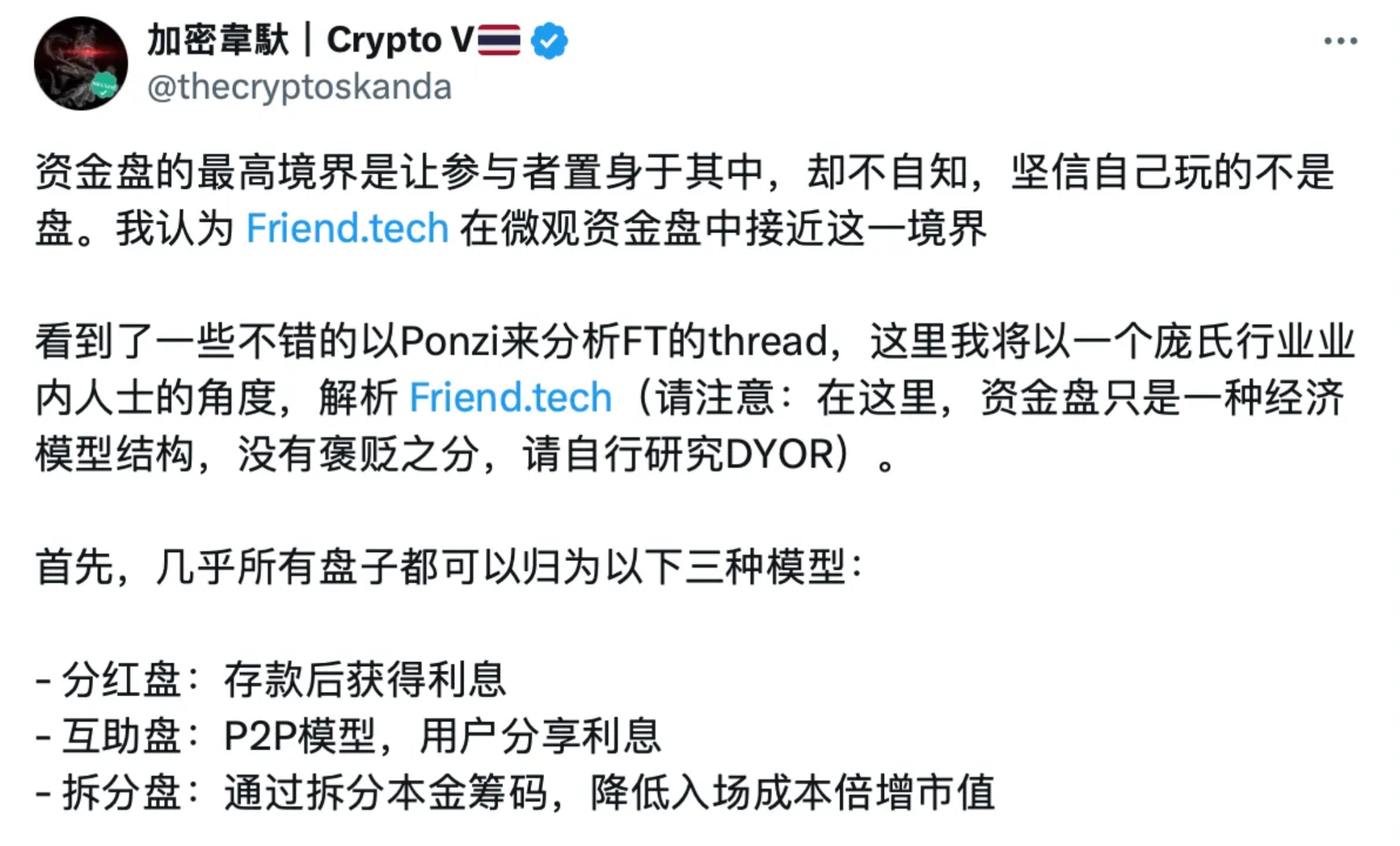
https://x.com/thecryptoskanda/status/1702031541302706539
The three plates refer to:
- Dividend distribution: Get interest after depositing, such as Bitcoin mining, Ethereum POS, and LP income.
- Mutual aid: P2P model, the focus is on flow mismatch, such as meme.
- Split the plate: By splitting the principal chips, the entry cost is reduced and the market value is doubled, such as Ethereum ICO.
The following is a summary of the main factors of the collapse of different plates:
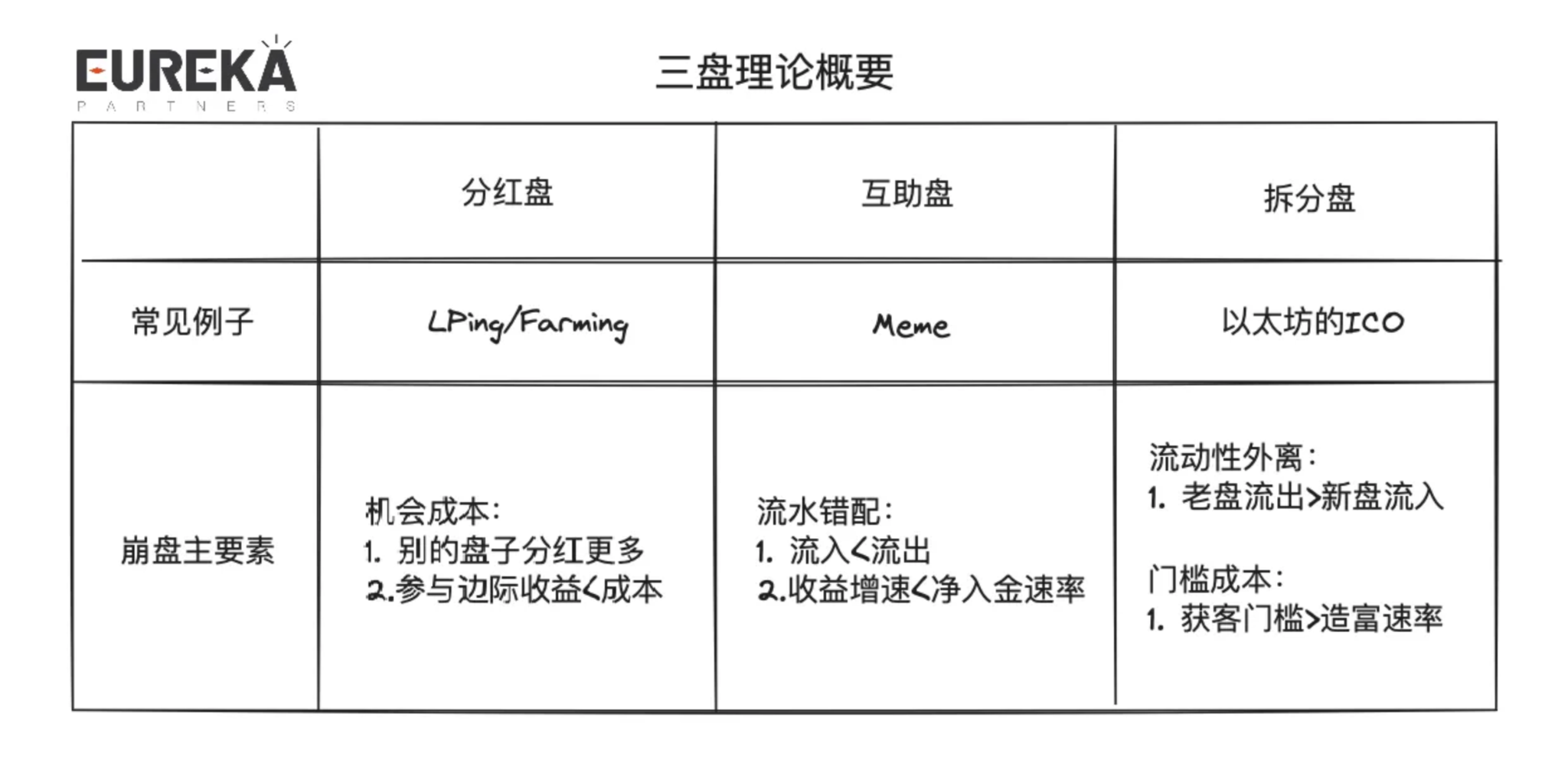
The life cycle of an ordinary plate is inevitably a death spiral and no takeover, but the life cycle of a good plate is cyclical, and may be composed of different plates and strung together, like an Ouroboros. Therefore, to understand a project, it should be a "modular" understanding, disassembling it by plate category, otherwise after the narrative period Fomo ends, the future trend of the project may be misunderstood.
As the saying goes, one gives birth to two, two gives birth to three, and three gives birth to all things. The Three-Disc Theory is not limited to the "three disks", but the coupling relationship between the disks, which truly realizes the endless cycle of life.
The author briefly explains what kind of cases different combination plates will have:
- Dividends first - dividends later: LRT. The user's ETH will first be pledged in POS (to obtain the first-layer dividend income), and then authorized to AVS (to obtain the second-layer dividend income).
- Dividends first, mutual assistance later: peer-to-pool lending protocol. Users first pledge tokens to obtain initial collateral income, and then other borrowers lend collateral to increase users' collateral income.
- Dividends first, split later: ICO on the POS chain. Participate in the P2P network with native tokens, get block rewards, and deploy non-native/copycat token contracts on the network to capture the liquidity of other users.
- Mutual assistance first, then dividends: OHM/Reserve Currency. OHM is theoretically anchored at 1 USD. After purchasing at a premium, other pledgers can get more dividends.
- Mutual assistance first, then mutual assistance: hybrid lending. Borrowers can match peer-to-peer lenders first, and then match peer-to-pool lenders if liquidity is insufficient.
- Mutual assistance first, then split: Runestone. Users first hype Runestone, and then Runestone holders can get airdrops from various projects.
- Split first - then dividends: Non-native interest-bearing assets on the chain. Non-native assets are generated from ICOs, and dividends are paid in other tokens/native tokens.
- Split first - then cooperate: frend.tech. Users can set up new targets with low thresholds, and then still use new money to cover old money.
- First Split-Then Split: Bong Bears. Bong Bears is an NFT that has undergone multiple rounds of rebases. Bong Bears gave birth to Bond Bears, Bond Bears gave birth to Boo Bears… and then there were Baby Bears and Band Bears.
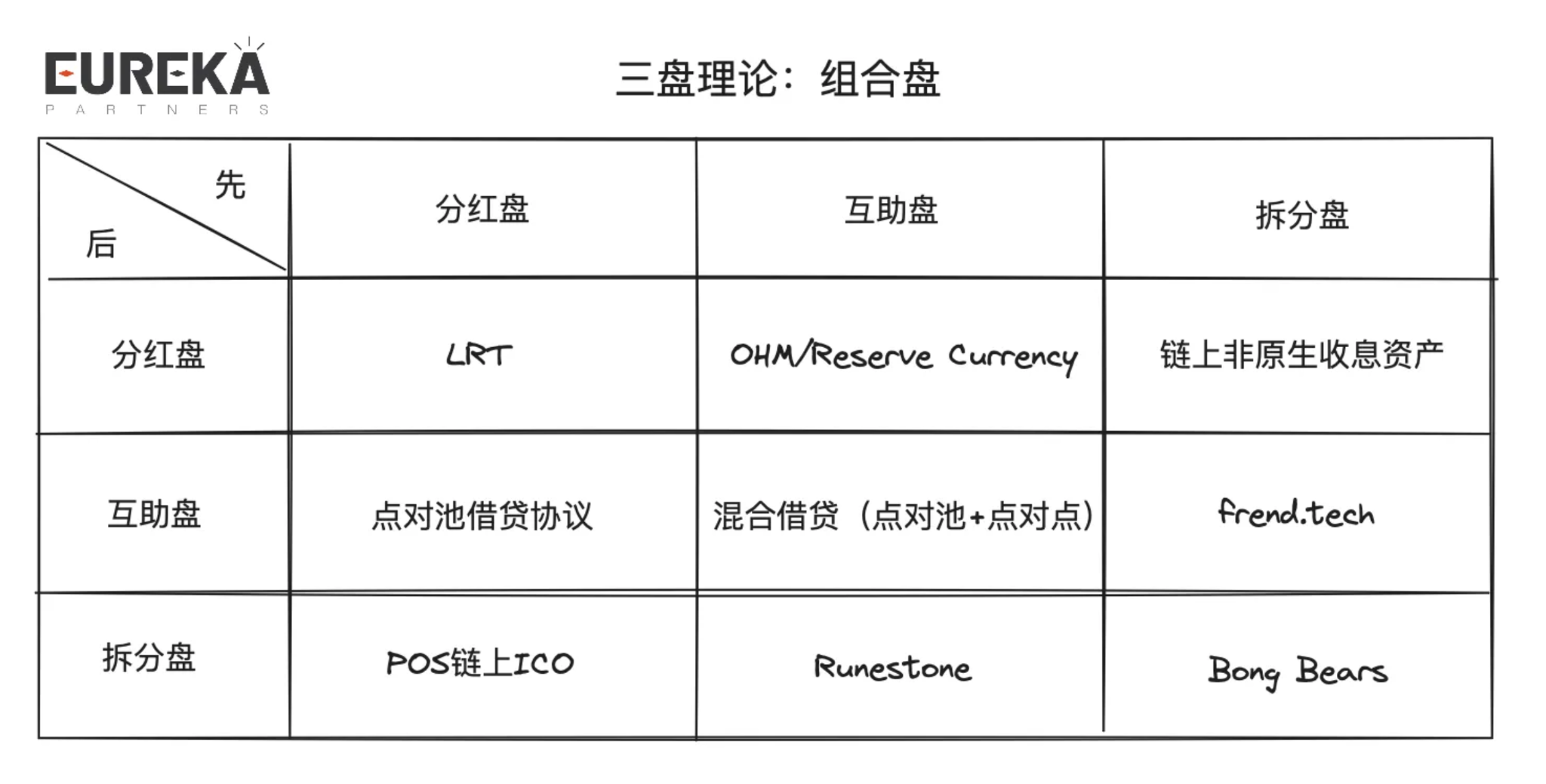
It can be clearly seen that the above combination and judgment of different disks are relatively subjective. From a practical point of view, the combination of disks in a project may not be limited to 1-2, but may be as many as 4-5. But is more necessarily better? This is related to the resources that can be deployed for a project, or to put it bluntly - the ability to operate the disk. The resources that can be deployed also determine how the relationship between disks can be handled, that is, parallel or serial (here refers to the concept of computer thread processing).
Parallel: The relationships between different disks in a project’s business do not conflict with each other, and multiple logics can be implemented separately. For example, there are many protocols in the public chain ecosystem, and there is unnecessary business coupling between protocols.
Serial: There may be conflicts between different disks in a project's business, and the business logic needs to be prioritized. For example, the LRT protocol logic uses serial processing, and the user's ETH will be pledged in POS first, and then authorized to AVS to obtain two layers of income.
After understanding the essence of Defi, let us return to the question: What is the end of Defi and why do some projects reach a dead end?
The end of Defi is essentially the beginning of the next Defi. The ending of most projects going to a dead end is just in line with the natural life cycle of the plate, reaching their own main factors of collapse, and other projects have taken over their liquidity. Looking at the entire Web3 industry from a high dimension, it is still "enduring", which shows that the relationship between the plates built by the Web3 ecosystem is in line with a healthy ecosystem. Observing various ecosystems, projects, and protocols with this logic, we can find that their life cycles will become shorter as the dimensions become lower, which is a reasonable phenomenon. Therefore, the "turnover rate" of the plate represents the health of the project, and the "turnover rate" of the project represents the health of the ecosystem. Next time, don't just say "no one takes over", you should be more cautious about each project's collapse, and abstractly decouple the business logic, and no longer be fooled by those seemingly high-sounding concepts.
Does this mean that Meme is the healthiest? After all, the initial cost is low and the turnover rate is high. From this understanding, technological breakthroughs are not important. As long as someone recognizes this narrative, it can continue. Is this really the case?
If the dimension is only placed in the Meme track, then the continuous flow of new plates covering old ones can be understood as a healthy operation. However, if we raise the dimension to the entire public chain ecosystem, only the Meme track can continue to thrive. Does this really mean that the public chain is healthy? I believe you also find it a little weird. Although in practical terms, we often see the explosion of a certain track, we jokingly call the rise of the xx chain and regard its explosion as a sufficient but not necessary condition. However, with a little thought, this explosion may bring about a sharp drop in the liquidity of other ecosystems of a chain, and even make the fate of the original chain currency price strongly bound to a certain track. This is not what most chain project parties want to see (Appchain is not considered here). Therefore, in most cases, the explosion of a certain track should be a necessary but not sufficient condition, that is, the traffic of a certain track cannot infer the development of the entire chain, and the trend of the chain should be able to reverse the traffic of its ecology.
Can Berachain achieve “eternal growth”?
After reading the above, I believe many readers have already started to have a preliminary understanding of Berachain. Let’s not rush to interpret the project, but take a step back and think about what is the core of a chain?
Yes, liquidity. Liquidity is the nutrient of everything. It determines the subsequent development of the ecosystem and also represents the popularity of the chain. In the past, the public chains of the halal faction ignored this key point and only engaged in marketing, trying to "draw liquidity" from other chains. Then what? Nothing, and they were not prepared to consider how to better manage users' funds.
"Retaining liquidity is the job of the project side, isn't it? What should the public chain side do? We can only provide the best three-piece development package, and the rest depends on fate."
In the most ideal situation, the public chain can also create some narratives to allow the ecosystem to take on this liquidity, but the scale is never at the public chain level. Currently, the most ideal narrative that can carry the public chain-level liquidity is LRT+AVS, while other chains always find it difficult to get out of relying on track-level narratives and will only be limited by the development of a certain target. For example, BTCL2 is limited by the outbreak of inscriptions and runes.
From this moment, we can reposition Berachain. I think the best way to understand Berachain is as a “pilot of liquidity”. Readers who are not familiar with Berachain can find many interpretations of the three-coin model + POL written by many colleagues on the Internet. I will not bother to explain it here, but just briefly introduce the token model of Berachain:
- Three currencies: BGT (governance), Bera (Gas), Honey (calculated as stable)
- Key process: BGT can be obtained in the Berachain native application (subsequent mainnet may be released on more protocols), BGT can be used to "guide" the BGT release amount of different LP pools; BGT is not transferable, but can be exchanged for Bera at a 1:1 ratio. Friends who are familiar with Defi can basically understand it as a variant of ve(3,3).
- Note: BGT is currently only available on officially deployed protocols (BEX, BERPS, BEND), but will be open to all protocols deployed on Berachain after the mainnet goes live.
The author believes that Berachain's token model should be viewed in conjunction with the ecosystem, rather than simply as a product. Here, the author uses Berachain's three-disk theory to explain the process of positive ecological development:
- Dividend distribution: Users/ecological project parties pledge assets as LPs and obtain BGT release income.
- Split: BGT can be used to pledge to become a governor, or authorized to other governors; BGT governors can decide the amount of BGT released by different LP pools.
- Mutual Aid: Ecological projects offer bribery rewards to attract BGT governors, and ecological projects gain potential liquidity from higher BGT releases.
- Split plate: users purchase tokens of different projects from the LP pool.
- Dividend/Split/Mutual Aid: Users’ assets flow in and out of different ecological projects.
Therefore, the main collapse point of Berachain is: BGT staking income < BGT exchange income for Bera. This also tacitly acknowledges that the on-chain ecology can no longer support more bubbles, and also means that as long as there is no systemic risk, Berachain's native assets (BGT, Bera, Honey) have ecological cushions. However, from a practical point of view, this matter will be more complicated, because not all participants have clear enough global information and make absolutely rational judgments, and not all participants are investors. Some project parties may purchase BGT to vote to obtain BGT release income to obtain potential liquidity, so this collapse point should be modified to: in a rational market, the project party's bribery income < the cost of purchasing liquidity (bribing, directly purchasing BGT) / BGT staking income < BGT exchange income for Bera.
It is not difficult to find that this is a seesaw mechanism. When the implied value of Bera/BGT is high, the potential exchange pressure of BGT will be very high. Once there are fewer BGT pledgers, the absolute return of BGT pledge should become higher, which will push up the willingness of BGT pledge, and the implied value of Bera/BGT will become lower. However, when there are more pledgers, the profit space will also decrease, and the implied value of Bera/BGT will become higher again... Repeatedly, a healthy Berachain ecosystem should maintain a positive premium of Bera/BGT for a long time, which means that the ecosystem has more trading volume and is "should" be willing to pay more bribery rewards to BGT pledgers. However, considering the actual situation, the bribery reward quota for purchasing liquidity is not a "dark forest". Rational project parties can refer to the bids of friendly companies to set prices, or conspire to set prices so that the liquidity attractiveness can be determined by the free market again, and finally they will only return to an average return line of "market equilibrium".
In addition, another hidden point of collapse for Berachain is that the LP staking income is lower than that of other DEX self-organized LPs in the ecosystem, which means that users will be lost due to "vampire attacks". In actual fact, this problem is not a big deal for two reasons:
- Berachain’s native DEX should have the most trading pairs, and it is also the DEX that small projects should choose for cold start/IDO. Therefore, in terms of user experience, it can provide the widest range of trading routes and will not cause a huge amount of liquidity outflow.
- Berachain's native DEX has the strongest brand power, which is difficult to match by other DEXs. You can refer to Uniswap's rapid rebound after being attacked by Sushiswap vampires, which shows the important influence of brand power on users' trading mentality.
Defi Liquidity Game: Has Berachain fundamentally changed anything?
For Defi, even though it has different forms, the core element is still liquidity. Therefore, how to attract and distribute liquidity in product structure has become a measure of sustainable development, especially for public chains. Below, the author will briefly review some liquidity solutions that have appeared in the past few years, and compare whether Berachain's solution has solved the liquidity problem from the essence.
Option 1: Liquidity Mining
Subsidize LPs with only fee income with the project's native token. Applicable to early Defi, when users have not yet been affected by the dazzling product model, this simple and effective subsidy helps to quickly capture liquidity. The most classic case is Sushiswap's vampire attack on Uniswap, which subsidized $SUSHI tokens with LP mining to capture $1.4 billion in liquidity in the short term. But the problem is also obvious. This dividend is not U-based, and the more liquidity, the less dividends, so the tokens mined by early users will only be quickly exited in the secondary, accelerating the possibility of the project's collapse. Nansen's 2021 report has already pointed out that 42% of the LPs who entered on the day of the launch of liquidity mining withdrew within 24 hours. About 16% of LPs withdrew within 48 hours, and by the third day, 70% of users will have withdrawn. If it were today, this data would not be surprising. If it were not a diamond hand or a believer in the project, which user would be willing to run with it.
Option 2: CLMM/Other AMM variants
Liquidity aggregation is achieved by changing the ordinary AMM (CPMM, constant product market maker) model. The most famous algorithm is CLMM, which is actually more like countless independent liquidity pools in different price ranges, and the user experience is seamless. This approach is to achieve a balance between the order book and CPMM, improving capital efficiency while ensuring sufficient liquidity. For further explanation, readers can directly look at Uniswap V3 or the V3 fork on the market. I will not explain too much here. This iteration of the solution does not harm the platform token, so basically everyone has a set.
Option 3: Dynamically distributed AMM
The liquidity range is adjusted through passive/active methods, but its core idea is to ensure that liquidity achieves the highest capital efficiency. For more details on the plan, please refer to Maverick Protocol. It is similar to manually and repeatedly redeploying the CLMM range. This approach allows users to experience transactions with lower slippage, but the trade-off is that a "price buffer zone" is established. The potential cost of market value management for the project party will be higher (for example, it is more difficult to pull the market), so the correlation of token pairs using dynamically distributed AMM is higher, such as LST/ETH.
Solution 4: VE model
The more classic VE model was proposed by Curve. After staking governance tokens, users can obtain some certificates, called VE tokens, which can be used to determine the income ratio of liquidity mining in different LP pools, that is, the dividend income of governance tokens. In short, governance tokens can be used to determine the distribution of governance token release in LP pools . Because governance tokens can determine the allocation amount of liquidity mining, it leads to a demand from project parties - guiding liquidity, aiming to provide deeper trading depth to ensure sufficient liquidity to undertake. Therefore, project parties are willing to provide more rewards for "bribing votes" related to governance, mostly in the form of project native tokens. Early projects would choose to outsource the bribery platform, but now more new solutions will use built-in bribery modules.
Option 5: Reserve Currency/OHM imitation
By selling bonds at a discount to collect liquidity, and issuing stablecoins with this liquidity, because stablecoins should be anchored to $1, once there is an over-purchase, the remaining liquidity is regarded as profit and distributed to the pledgers of the stablecoin. In theory, this method can operate sustainably, but in reality, users do not regard these tokens as stablecoins, but choose to over-purchase the stablecoins and pledge them to obtain treasury surplus income. Under the combination of pledge, bondization, and secondary market purchases, the value of the stablecoin will be pushed to a level that is far from what it should be. If a huge amount of profit-taking positions are closed, there will only be further runs, and finally even a return to a level below $1. The OHM game situation is also called the (3,3) model. From the above, it can be found that users all choose to pledge, so expressed in a 3x3 matrix, it is (3,3).
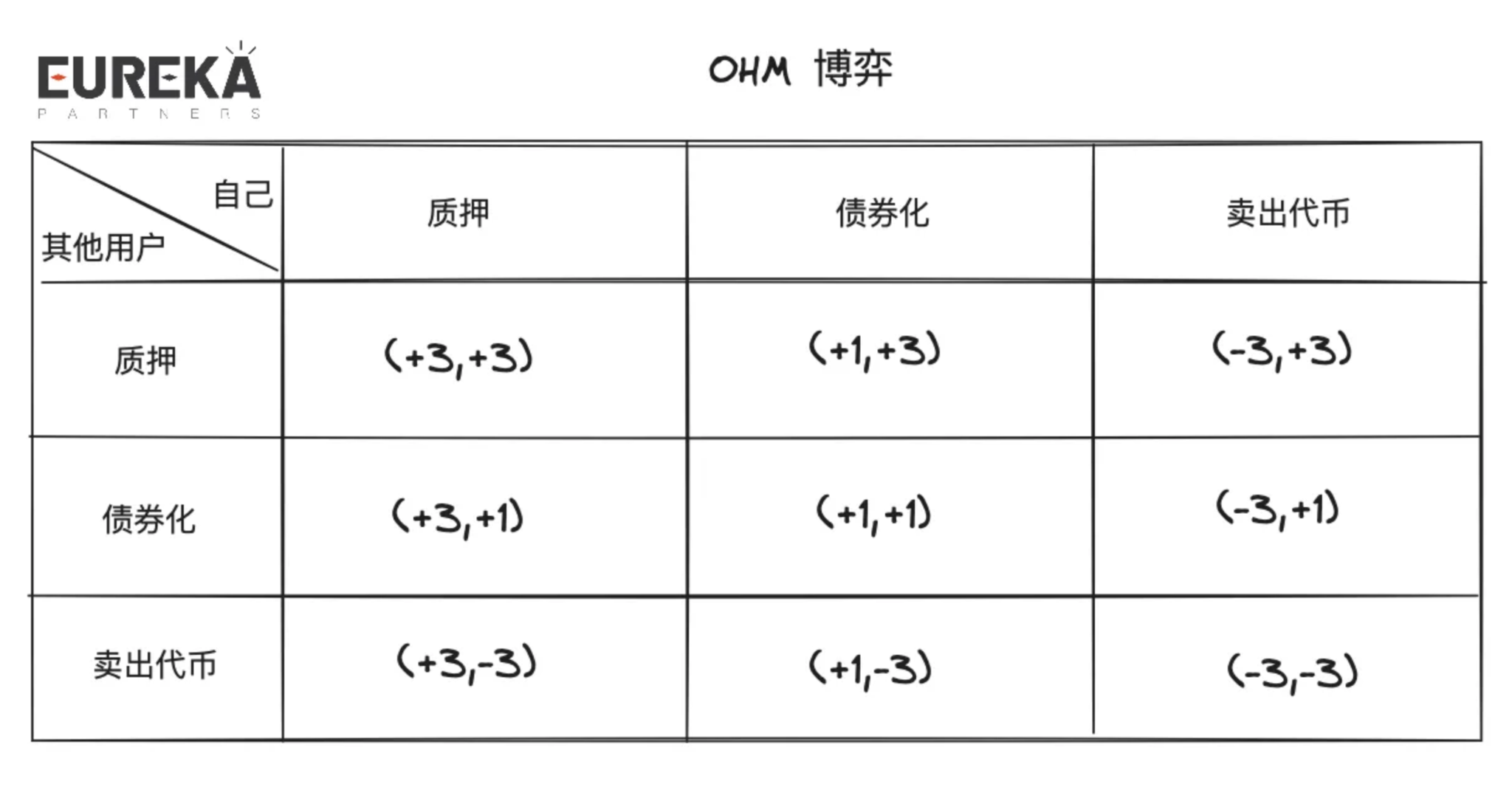
Solution 6: VE(3,3) model
Different from the ordinary VE model, VE(3,3) pays more attention to the local optimal consensus. Therefore, the project party will create an environment to guide the holders of the governance token to choose in the direction of the local optimal. The LP fee of the VE model mentioned above is actually a global dividend, that is, all governance token stakers have income. However, the LP fee of VE(3,3) mostly only appears in the voting for the governance of the pool. The stakers need to estimate the subsequent share of different LP fees before choosing to vote. So in a sense, the bribery platform also provides a local consensus so that users can actively obtain the most benefits. Therefore, whether it is LP fee isolation or bribery market, it further allows internal competition in the liquidity market and tries to attract liquidity in a "single-blind" situation, that is, it is impossible to determine how much liquidity the liquidity provider will provide. This part is always opaque. In addition, the biggest difference between the bribery market and the LP fee is the way of revenue pricing. The former is priced by the project party token, and the latter is more common in U-based pricing. Therefore, the former can be used as a buffer zone for the entire DEX, and the price of the governance token can still be maintained before the revenue bubble ends.

Solution 7: Reverse VE(3,3) Model
The positive (3,3) emphasizes the global optimal solution of income, while the negative (3,3) increases the user's unstaking cost/coin holding cost through the loss mechanism. Readers may understand that there is a risk of depreciation for traders holding tokens, but this type of project is often seen in group friends, and is euphemistically called the native deflation mechanism. The conventional projects on the market adopt this model in a slightly conservative way. For example, GMX does not mean that not staking will lead to depreciation of the principal, but unstaking may lead to a part of the dividend loss. Readers can go online to read the interpretation of GMX. The use of this model requires the project party to fully understand its own business and understand the life cycle & design logic, otherwise it will only accelerate the death of the project. Whether the token value is too high or it depreciates rapidly, it is not what a long-term development project wants to see.
Solution 8: Liquidity Guidance
There are generally two roles in liquidity guidance: LP and LD (Liquidity Director). LP still provides liquidity, while LD is responsible for deciding where the liquidity will go. Tokemak is one of the few liquidity solutions that uses this solution on the market. V2 has also been iterated, using an internal algorithm to obtain the optimal solution for the liquidity guidance route, so that LP can obtain the best mortgage income, and liquidity buyers can clearly know how much money can "lease" how much liquidity. The liquidity marketplace has not yet been opened, but more than 8M liquidity has been accumulated. Judging from the past currency price performance, this narrative has only received attention in the last round of Defi Summer. In the bear market and this round of bull market, it has not performed much. Whether the liquidity market needs market transparency is still a question that needs to be verified later. The author believes that a certain degree of "clear pricing" is needed in the liquidity market, because there are blind spots, the bidding will be inefficient, and there are many potential idle rewards that cannot be correctly distributed to incremental funds. This type of solution will serve as a terminator in the market liquidity game, just like MEV-boost to MEV Dark Forest.
Option 9: VE-LP / Proof of Bond (POB)
Finally, we come to the main point of this chapter, which is also the core reason why the author believes that Berachain POL is not innovative.
The core idea of VE-LP/POB is to introduce liquidity as a project entry ticket & back line. The former can be seen in Balancer, and the latter can be seen in THORchain. Balancer allows users to be LPs in BPL/WETH, and the LP certificates they obtain can be further pledged to obtain veBAL for fee sharing and governance. THORChain POB requires node operators to pledge their native tokens as underwriting funds, and LP losses will deduct 1.5 times the collateral assets as compensation. The liquidity hard cap carried by the entire network will be 1/3 of the governance token. When the network becomes unsafe/inefficient, the balance point will be sought through liquidity mining <> node operator income distribution. For example, when the network node collateral assets are not enough to repay the on-chain liquidity loss, the release of the next period of node income (governance tokens) will be increased. No matter how the details of these schemes change, the core problem will be that there will be an entry threshold, so how to set a reasonable entry difficulty to maintain sufficient liquidity is the key.
So when we look back at Berachain's POL+three-coin model, it is essentially a variant of the VE(3,3)+VE-LP model. As mentioned above, the BGT bribery market is an application of the VE(3,3) model, while POL is an application of VE-LP. The core of the former lies in the market value management of governance tokens, and the core of the latter lies in the entry threshold. Generally, the governance tokens of the VE model on the market are traded freely in the secondary market, so for ecological project parties, they can purchase liquidity at will, but the VE model project parties themselves face the risk of token fluctuations. However, the POL method slows down the acquisition of governance tokens (BGT), which gives more time and space for control to a certain extent. At the same time, POL allows multiple types of tokens to be pledged, which lowers some entry thresholds in exchange for more potential liquidity.
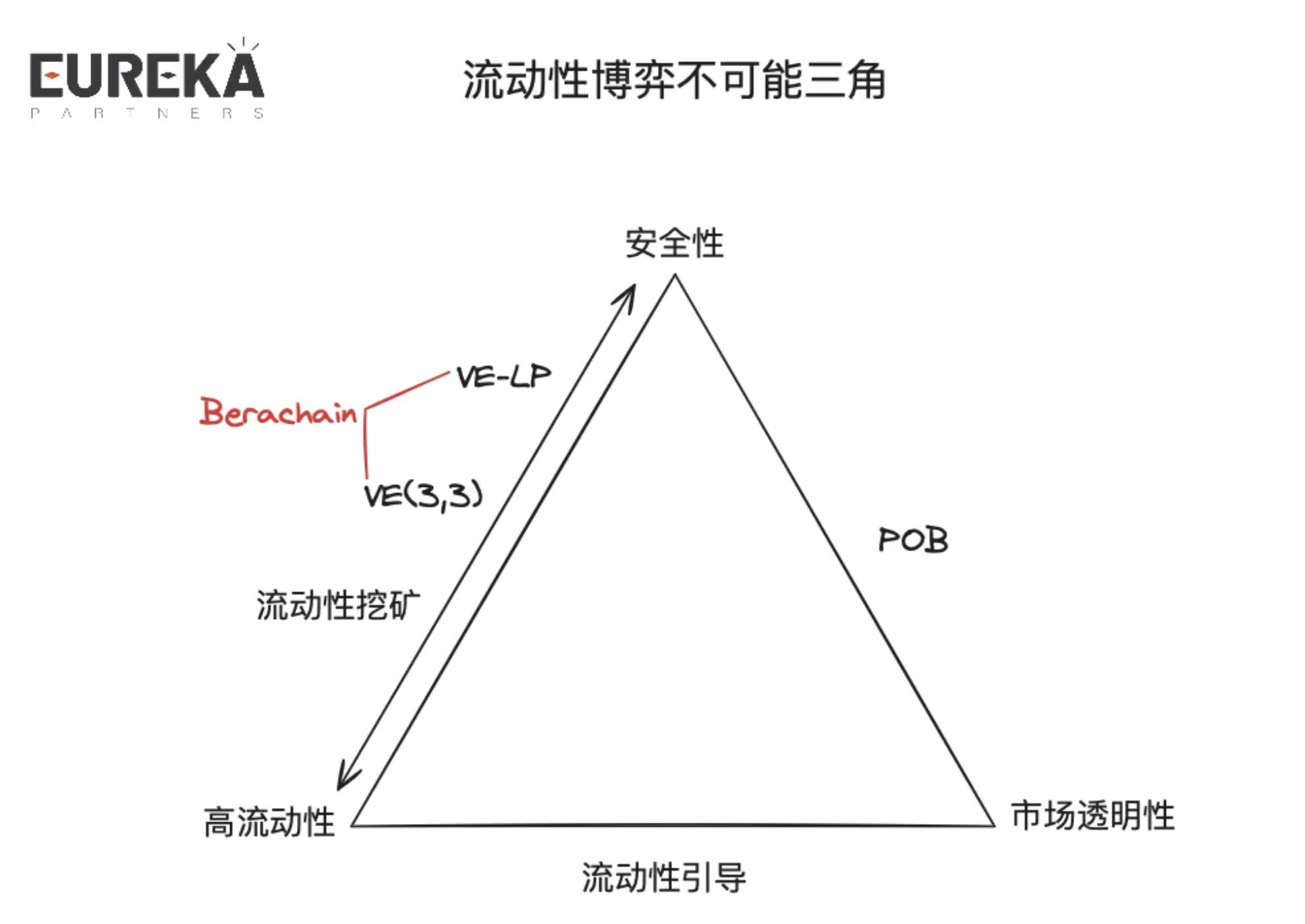
The above series of liquidity solutions can summarize the impossible triangle of liquidity game: security, high liquidity, and market transparency.
Security: refers to whether the solution can provide a line of defense for liquidity to the project party. For example, if the bubble of bribery income in the VE (3,3) model bursts, the VE project party may collapse.
High liquidity: refers to whether the plan can attract absolutely high-value liquidity. For example, if the project party is willing to cede most of the governance tokens, then this income will attract a batch of short-term liquidity.
Market transparency: refers to whether the solution can make the market demand for liquidity transparent. For example, the liquidity that a POB project can carry is determined by the total amount of node assets.
Back to the question itself: Has Berachain essentially broken through the technical bottleneck of the liquidity market? The answer is obvious: no, it is only a partial improvement. But Berachain has chosen the right application scenario - public chain. If we only focus on the mechanism, we will misjudge that this potential is only at the protocol level, but the actual BGT token bribery reward can also revitalize other projects in the ecosystem, and can even be regarded as a narrative of the same level as Restaking. Imagine that you are now a project party, and you do not have enough funds to use as liquidity mining as an early reward, but you still set up a trading pair on BEX (Berachain's native DEX) and equipped with a certain amount of liquidity. At this time, the project can obtain BGT income from these pledged liquidity, and BGT can determine the subsequent release of the pool. Because the pool is small, even a small amount of BGT release is higher than the LP income of other blue-chip tokens, thereby indirectly attracting liquidity. From this logic, Berachain's POL mechanism is actually a bit like the Restaking track. Because the AVS in the Restaking track integrates part of the security of ETH, and Berachain's small project is also integrating part of the "security" of BGT, it provides more sufficient liquidity for the subsequent development of the project.
What’s happening at Berachain and what’s the best way for users to get involved?
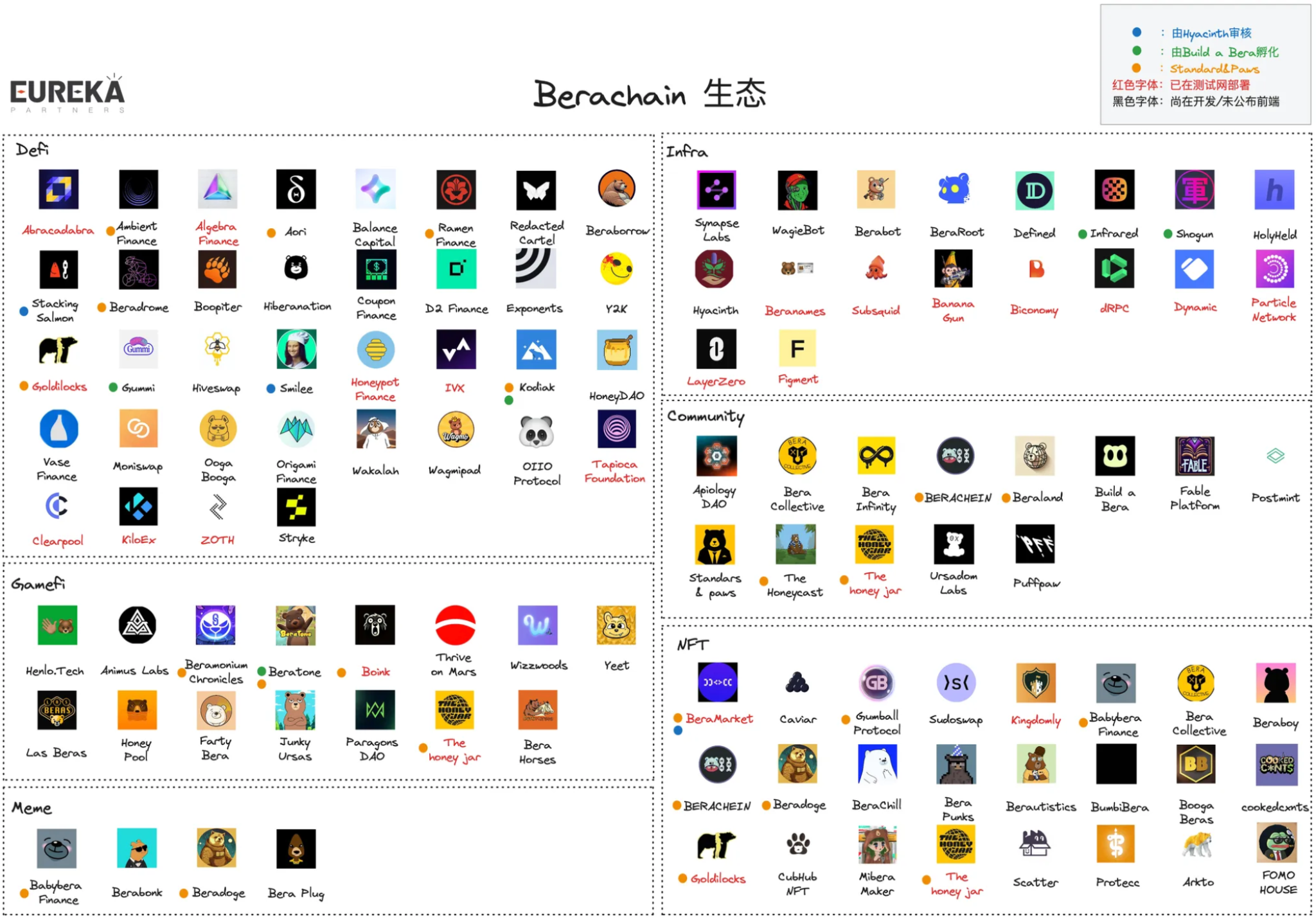
As of May 3, 2024, according to the compilation by Beraland and the author, there are currently about 103 projects, of which Defi and NFT account for the majority. Since a project may have multiple businesses, the author also divides such projects into business categories. The specific ecological distribution is as follows:
- Defi: 36
- Gamefi:15
- Meme: 4
- Infra: 18
- Community: 13
- NFT: 24
Currently, most of the projects are Defi and NFT products. Berachain’s ecosystem is quite complex, so I only introduce some key projects (relatively subjective).
- The Honey Jar (THJ)
“The Honey Jar is an unofficial community NFT project, situated at the heart of the Berachain ecosystem, which hosts a number of games.”
The above is the official positioning, which can basically be understood as a hodgepodge project of NFT+Gamefi+Community+Gateway+Incubator. Its NFT is called Honeycomb, which can be used for governance within the project. At present, all Honeycombs have been minted, with a floor price of 0.446ETH and an initial minting price of 0.099ETH. NFT holders can participate in the platform's games and obtain some mysterious rewards from other potential Berachain project ecosystems (as of February 22, 2024, HJ has accumulated cooperation with 33 projects , and about 10 projects have provided airdrop rewards), and Berachain's ecosystem can "position" valuable high-net-worth users through these NFT holders, and potentially increase the future participation of the project (high-net-worth users may be willing to invest more). In short, this is an NFT that requires "project parties to do things."
In addition, every quarter, The Honey Jar will release new mini-games and allow users to mint a new round of NFTs, for a total of 6 rounds. These NFTs are different from Honeycomb and are called Honey Jar (Gen 1-6), and the Gen number of this round is determined by the round. Users who purchase these NFTs can participate in the game, which can be understood as an NFT lottery game, and the lottery will be held after all the current NFTs are minted. The winners can receive the rewards in the prize pool (NFT + bonus). Two rounds of the game have been carried out so far, and the remaining four rounds will be announced in 2024Q2 and deployed on 4 different EVM chains.
THJ has incubated 6 organizations:
The first is Standard and Paws, which is a rating system that aims to prevent junk projects from appearing in the ecosystem.
Second, Berainfinity, which can be understood as Berachain’s Gitcoin, helps developers/project parties develop sustainably.
Third, ApiologyDAO is positioned as an investment DAO in the Berachain ecosystem.
Fourth, Mibera Maker, which is positioned as Milady of the Berachain ecosystem.
Fifth, The Apiculture Jar. It is positioned as the Meme/Artist department of THJ.
Sixth, Bera Baddies. It is positioned as a female community on Berachain.
Evaluation: I think the early participation value of this project is relatively high, and no one will dislike "shovels". However, this kind of narrative generally has the opportunity to price in early, so we must be clear about other core collapse/risk points besides systemic risks (Berachain mainnet subsequent performance decline):
First, the project party has sufficient bargaining power and BD capabilities, and can "use OG to control the project party." If this narrative is proven to be unable to truly capture high-net-worth users, then no subsequent project party will be willing to provide high-value benefits to NFT holders.
Second, the total value of potential rewards provided by other projects to NFT holders needs to be greater than or equal to the floor price of NFT. Let's conservatively estimate the price of Honeycomb:
1) Honeycomb cost price: 0.099ETH is approximately equal to 300U
2) Predicted returns: The risk-free return on the chain is about 5% (POS); currently 10 projects are willing to pay for airdrops, and each project's airdrops are distributed approximately in 6 months, with an initial value of 30U (10% Expected rate), and a theoretical total value of 300U (30U*10), which means 50U will be issued every month; assuming that there are 3 new projects willing to airdrop to NFT holders every month.
3) Income growth rate: Assuming that in the first three months, the project party is washing the market and waiting for low-buying before pulling up the market, the price will be pulled up by 1 times, 1.25 times, and 1.25 times respectively in the next three months; assuming that the institutional price will recover at 5-10 times the price point on the day of TGE, and the release period is 12 months, it means that the project party needs to pull up the price by 2.5-5 times within 6 months (approximately equivalent to pulling up the price by 1 times, 1.25 times, and 1.25 times respectively in the next three months).
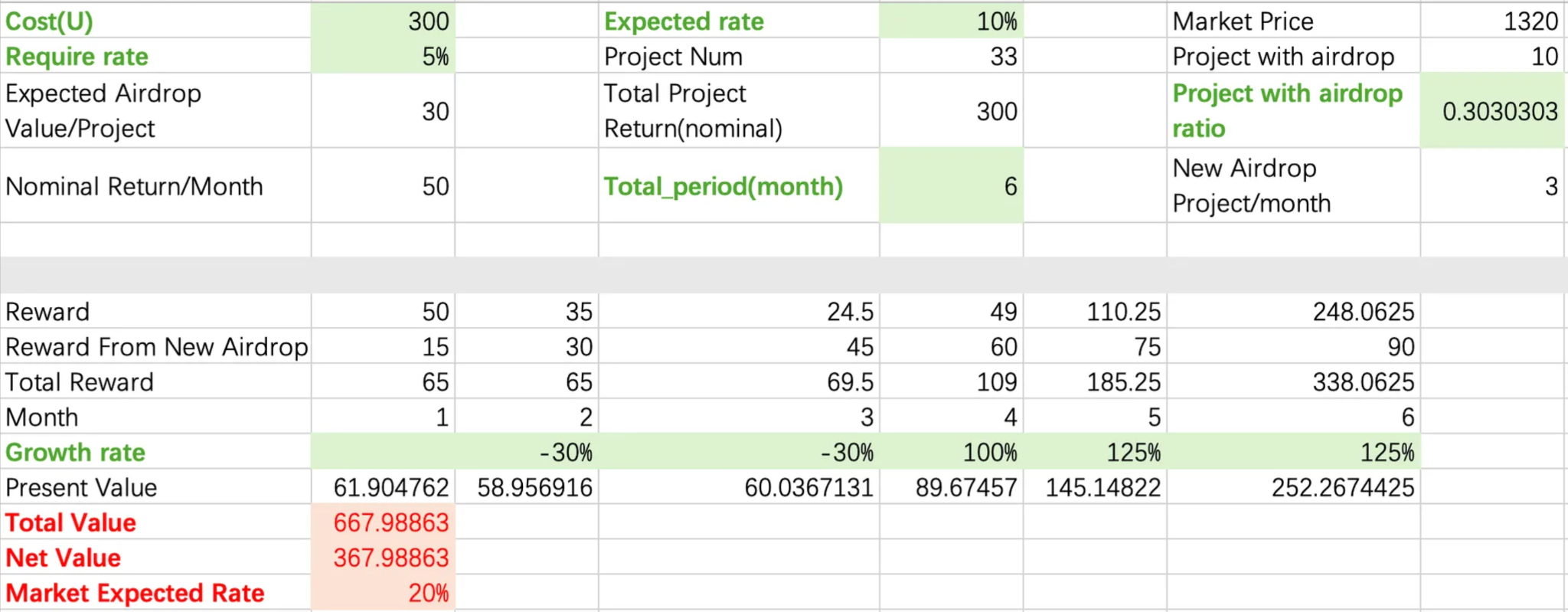
The final estimated NFT net value is 367U. If estimated based on the current floor price (0.446ETH), the market forecast of the return value of a single project needs to be maintained at 20%. The above estimate is for fun and has little actual reference value.
- Build a bera
“Build-a-Bera is a results-driven partner with the Berachain Foundation designed to provide Bera-oriented founders with the tools, mentorship, and resources needed to thrive in a competitive market.”
According to the official definition, Build-a-Bera is a partner of the foundation and helps the project parties of the ecosystem to develop. In layman's terms, it is an incubator. Each phase recruits 5 project parties for a period of 12 months. The 5 project parties currently listed on the official website are: Infrared, Gummi, Kodiak, Shogun, and Beratone.
Evaluation: I think these selected projects are likely to get more support from Berachain, and the projects in the incubator are more likely to form cooperation (which is also true in fact). Therefore, I will introduce the selected projects mentioned above later.
- Infrared Finance
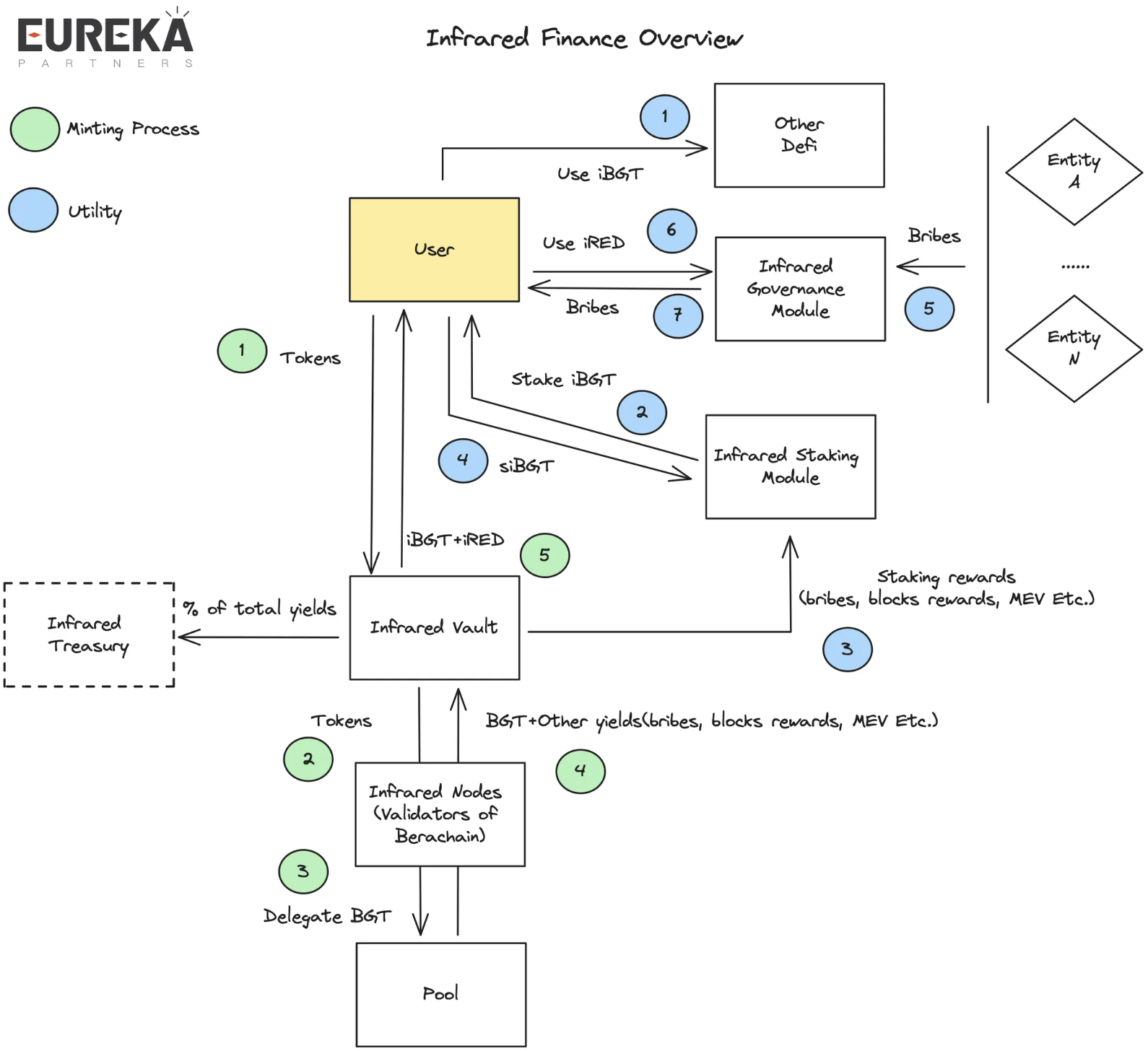
Friends who are familiar with Defi can regard it as a combination of Frax (frxeth+sfrxeth) and Convex. In short, Infrared Finance is an LSD project that aims to solve the BGT liquidity problem.
The general process is as follows: users stake tokens in Infrared Finance, which will then be staked in the BEX liquidity pool by Infrared Finance. The BGT income received will be authorized to Infrared's validators. Infrared validators will return the subsequent BGT release income + other income (block rewards, bribes, MEV, etc.) to Infrared Vault. Infrared will treat part of the other income as treasury income, and cast the accumulated BGT income in the pool as iBGT + iRED to return to users.
Token model: iBGT is pledged by BGT 1:1; users can use iBGT in other products on Berachain; users can pledge iBGT to obtain siBGT, and siBGT can obtain BGT income of Infrared validators, such as bribes, block income, etc.; iRED can be used for platform governance, such as guiding Infrared validators to increase the release of BGT to a certain LP.
Evaluation : Another project that "uses the emperor to control the world" . On the surface, it solves the problem of BGT liquidity, but in fact it shifts the battle for bribery from BGT to iRED . For example, Infrared Finance occupies 51% of LPs, which means that it has absolute say in the release and distribution of BGT. Naturally, iRED is the "imperial seal" that controls the world. On this basis, if the liquidity demand of the project party remains unchanged, the bribery income received by Infrared is theoretically higher than that of other validators, further exacerbating Infrared's control over Berachain. In reality, this may be more like a fact. For example, Convex's say over Curve once approached 50%. In addition, Berachain currently has no other LSD projects with Build-a-Bera support, and there are many ecological cooperations at present. If the user's demand is a relatively stable BGT income + part of the excess income, it can be expected that after the launch, the priority portal for users to pledge tokens is Infrared. In addition, the dual-token "seesaw" mechanism adopted by the project further amplifies the benefits of siBGT holders, because not all users want to sacrifice liquidity, so the benefits of this pledge should be higher than those of ordinary BGT LSD products, and the source is "real benefits". Although it seems to be a win-win product for all parties, we also need to understand some of its collapse points/core risks:
First, the risk of iRED depreciation. Each release of iRED will increase the total circulation, thereby indirectly reducing the value of iRED. The implicit value of iRED represents the benefits of bribery. If potential projects are willing to directly provide high bribes on the Berachain BGT Station for some reasons (such as the pursuit of decentralization), then the implicit value of iRED will become lower, thereby accelerating the depreciation of iRED. If Infrared can control the majority of liquidity, then it will essentially return to Berachain's POL mechanism. Strictly speaking, this is a systemic risk.
Second, Infrared’s centralization risk. Although Infrared currently has support from many parties, including incubators that cooperate with the foundation, their potential risk of malicious behavior cannot be ignored. At present, Infrared has not clearly stated their validator participation threshold. If it is completely run by its own people, it will have a greater risk of single point failure than Lido.
- Kodiak
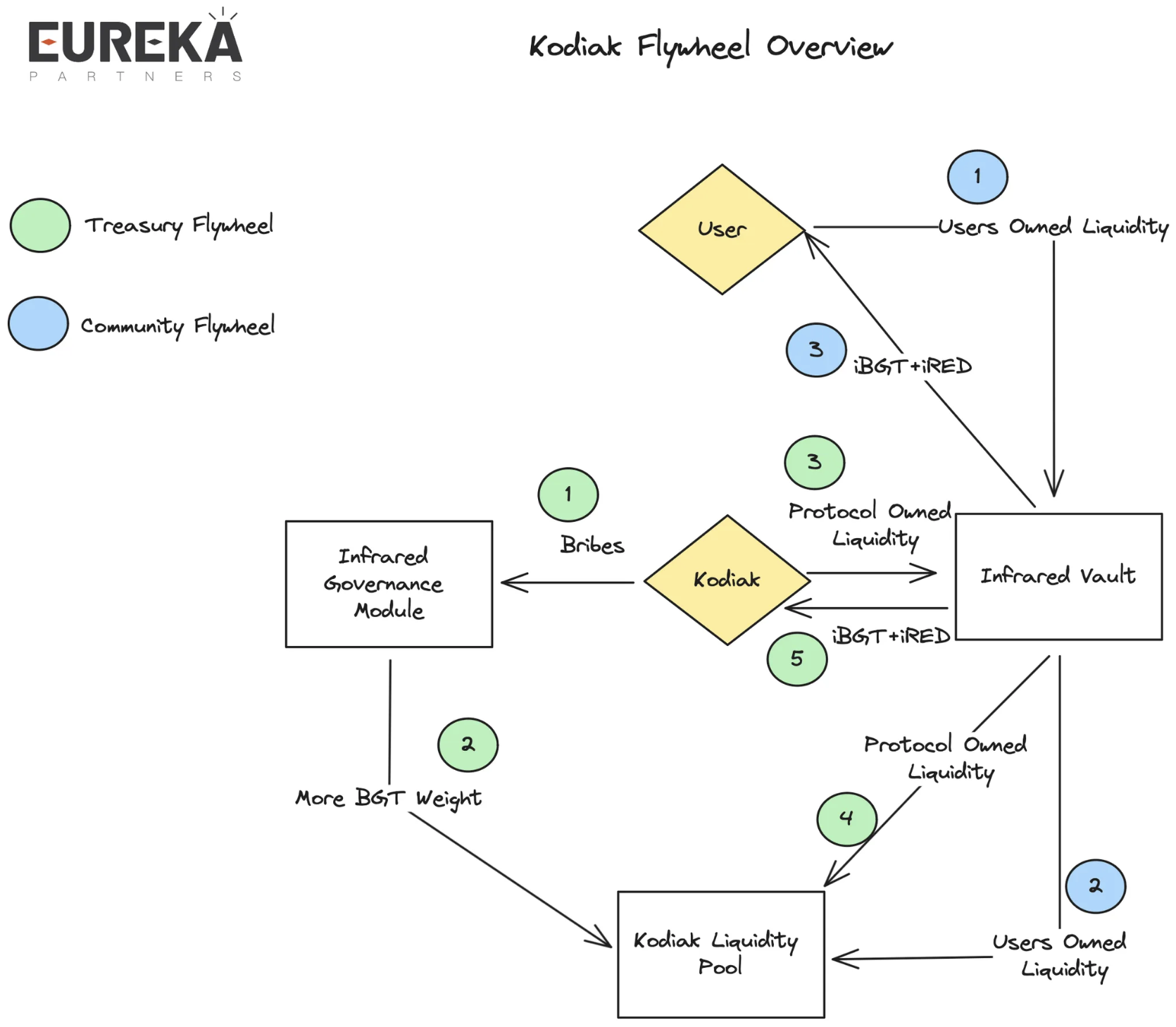
“an innovative DEX that brings concentrated liquidity and automated liquidity management to Berachain.”
Kodiak is positioned as a DEX and provides services for automated liquidity management (refer to the dynamic AMM overview in the liquidity solution above). In addition, it also provides a one-click coin issuance function. According to the official statement, Kodiak is not a direct competitor of BEX, but a supplement to the ecological niche, because BEX does not provide the function of aggregating liquidity. In addition, it is worth noting that Kodiak cooperated with Infrared and proposed two economic flywheels:
First, the Treasury Flywheel. Kodiak will first bribe Infrared to increase the BGT release of Kodiak LP. Kodiak will then pledge the liquidity of the Treasury in the Kodiak LP pool and pledge the LP tokens to Infrared. Infrared will then gain control of the LP and then pledge in the Kodiak LP pool to obtain Infrared's iBGT+iRED income.
Second, the community flywheel: Users can stake their Kodiak LP tokens and receive iRED+iBGT returns from Kodiak.
Evaluation: It is suitable for interest-bearing assets and native asset trading pairs, but may not be suitable for siBGT&iBGT scenarios. At the same time, the flywheel has high requirements for the mid- and late-stage control capabilities of the project. It is also mentioned above that the dynamically distributed AMM is suitable for token pairs with high correlation. For example, LST/ETH, LST (non-rebasing token) will accumulate the income of the validator, which should be higher than the price of iBGT, but because the income is stable income and will not be extremely volatile, the dynamic AMM will more easily form a price buffer zone, so that there will be no difference between the two. However, the native income of siBGT is different from POS, the source is more diverse, and the volatility is not low, so the price buffer zone makes the efficiency of price discovery lower, which potentially underestimates the true market income value of siBGT. In addition, the core collapse point of the project is that the bribe income (iBGT+iRED+liquidity stability) is lower than the bribe cost (most likely Kodiak native tokens) . This is basically a common problem for all bribery projects. This also implies that the implicit value of Kodiak tokens should be lower than or equal to the bribe income, otherwise the project will be in deficit (similar to the current situation of lido). But on the other hand, if the value of Kodiak native tokens is not high enough, it cannot attract enough liquidity, that is, there is not enough BGT release. * In the early stage, most LPs should think in terms of currency, which is a bullish signal . *When the bribe cost is greater than or equal to the bribe income, but in the middle and late stages, the ecosystem is weak, and LPs naturally need to think in terms of U. At that time, Kodiak will only have two choices: maintain the bribe amount in terms of U, or continue to bribe in terms of currency. The former accelerates the potential selling pressure in the market, and the latter reduces the attractiveness of platform liquidity. Both are at the critical point of collapse. If there is no other narrative, it is the end of the life cycle.
- Gummi
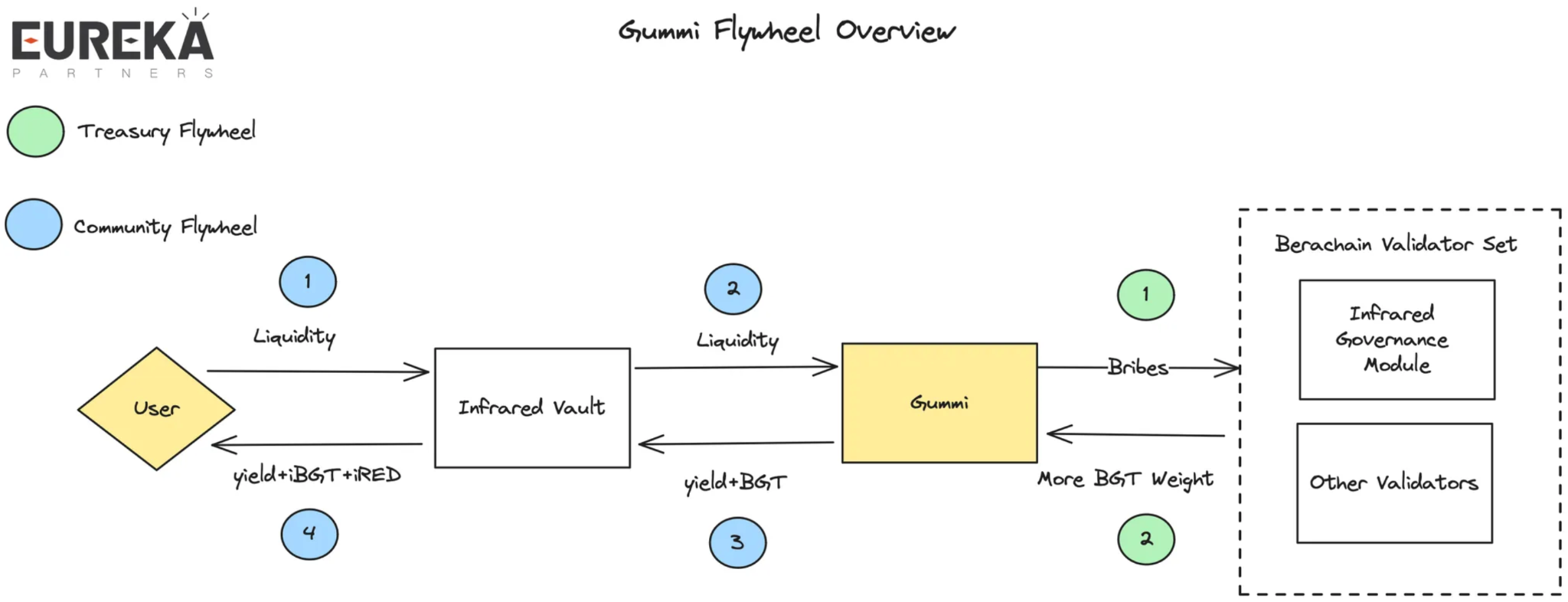
"A sweet treat for those sers interested in something a little stronger than honey."
According to the official description, Gummi is positioned as a money market. There is not much information at present, but it is likely to be a lending protocol and supports leveraged lending.


Their cooperation with Infrared is similar to that of Kodiak. Although Gummi did not explicitly state whether he would bribe Infrared validators or all validators, it is likely to be the former.
Comment: There is not much room for discussion on this project at present, because the product details are still unclear. However, since it is a Build-a-bera incubation product + Infrared ecosystem partner, it is mentioned here.
- BeraBorrow
“Beraborrow is a decentralized protocol at the forefront of the Berachain ecosystem, providing interest-free loans using the iBGT token as collateral. ”
Friends who are familiar with Defi can understand it as a copycat of Liquity. According to the official description, BeraBorrow is a collateralized debt protocol (CDP) that allows users to use iBGT to borrow NECT stablecoins at 0 interest + 110% collateral rate. The stablecoin is theoretically anchored at 1 US dollar.
Why is it interest-free: There is no real "interest-free" protocol. So our focus should be on where the protocol draws money. BeraBorrow will charge a fee every time a user lends NECT and redeems it. The redemption fee is dynamically adjusted based on the redemption frequency within 12 hours. The more redemptions (which means the value of NECT is overestimated), the more fees will be charged.
Anchoring mechanism: It is divided into hard anchoring and soft anchoring. The former provides a 1:1 redemption mechanism for iBGT and NECT. When NECT is overvalued (greater than 1.1 USD), you can exchange NECT worth 1 BGTi at a 110% mortgage rate on the platform, and then sell NECT to obtain the difference as income; when it is undervalued (less than 0.9 USD), you can buy it in the secondary market and redeem iBGT on the platform at 1:1, and the difference in the middle is the income. The latter refers to the theoretical anchoring value of NECT, which is equal to 1 USD. The platform adjusts the overvalued NECT through dynamic redemption fees.
Maximum leverage : 11x. Since the platform mortgage rate is 110%, theoretically you can open a leverage of 11x (1+1/0.1=11).
Other risk controls: A stable pool will be launched later for platform liquidation, and the liquidation proceeds will be given to the LP of the stable pool.
Evaluation: Stablecoin projects are essentially bonds. Users care about APY rather than the use scenarios of stablecoins (more trading pairs). If you really want to use stablecoins, why not use Honey? From the current product revenue sources, only the stable pool is a potential source of revenue, but it is not ruled out that the iBGT pledged on the platform may be further pledged in the Infrared vault to obtain potential revenue. So for users, if they are bearish on iBGT in the short term, they can increase leverage and wait for the bottom position to be liquidated to obtain potential liquidation spreads.
The maximum liquidation value of Liquity = debt value - ( the current price of the number of mortgage assets <10% * the proportion of users in the stable pool).
Let's take a simple example to estimate. Suppose a position has 500iBGT, 10,000 NECT debt, and the current mortgage rate is 109%, that is, the iBGT price is 21.8 U (109% 10,000/500). If the user accounts for 50% of the stable pool, it means that the user can get a profit of 450U (500 50% 21.8-10,000 50%). According to the above example, the key profit point of the user lies in the current proportion of the stable pool + liquidation frequency .
In addition, if users are bullish on iBGT in the medium and long term, they may be able to obtain up to 11 times the siBGT return by leveraging, but this business is not currently specified in BeraBorrow's official documents. For such users, the key risk point is the downward volatility risk of BGT.
- Beratone
“BeraTone offers an intricate life-sim and farming system, reminiscent of beloved classics like Stardew Valley, allowing players to cultivate and manage their dream farmstead.”
According to the official introduction, Beratone is an MMORPG. Players will play the role of a little bear and farm with various bears in a simulated world. Friends who are familiar with the game can refer to Stardew Valley. One of the creators of Beratone is PixelBera, who is also the artist of Bit Bears (the fifth-generation base derivative NFT of Bong Bears NFT). Thanks to the popularity of Bit Bears, PixelBera hopes to introduce some "utilities" to Bit Bears, and Beratone was born. The game demo is expected to be launched in Q2 of 24, and the official version of the game will be launched in Q1 of 2025. The sale of NFTs will be carried out in Q3 of 24. Founder's Sailcloth NFT has been sold, which will provide a variety of buffs in the game, such as increasing backpack space. It is worth noting that the game will be playable by everyone, and there will be no threshold restrictions, so the NFTs sold in Q3 are not admission tickets, and may also be similar to Founder's Sailcloth NFT.
Evaluation: The art style is close to Web2 games, but TBH, Web3 users are still pursuing APY, and the game is essentially a huge Defi. But as the project party of Gamefi, one of the rare advantages is that the economic model can be designed as a single-blind mode, that is, users are unclear about the benefits. With an appropriately long-term economic system and an in-app purchase system, the life cycle of a game will be longer than we think. In addition, Gamefi's income is calculated based on NFT standards, so it can also create an inflated market value through a low turnover rate to attract users to participate in gold farming, but it is more difficult to control the market than the U/coin standard. In short, if you are a fan of Bera, you can consider running with it. The odds of the game are relatively high. At the same time, you need to estimate the turnover rate of the secondary market and hedge risks through pre-market trading and OTC when necessary.
The above project introductions are relatively introductory and are not enough to provide readers with ecosystem-level insights. Therefore, the author has done some research on all the projects in the above ecosystem, which takes as long as 1 hour and as short as 5-10 minutes. Here are some of my summaries:
Strong nativeness of projects, different GTM strategies: Most of the projects deployed on Bera are not multi-chain compatible, but native to Berachain. The ratio of native projects to non-native projects is about 10:1 (Note: it is not ruled out that some products are from the same team). Contrary to intuition, not all non-NFT native project parties tend to use NFT issuance as a cold start, and most of them still follow the halal school.
Economic flywheels are complex, but they remain essentially the same: most projects deployed on Berachain realize economic flywheels through Infrared, and some projects further build multiple layers of VE (3,3) on the original basis of BEX, such as Berodrome. However, the core idea remains unchanged, and any incentive is based on currency, so users only need to understand the fundamentals and market-making capabilities of the project behind the token. The flywheels between projects should be coupled, but it does not mean that the flywheel effect of a project will collapse due to the collapse of a single project. As long as the ceded tokens can be exchanged for excess returns, users are willing to continue to protect the market and let other projects fill the gap in the flywheel.
Most of the highly funded projects issue NFTs: 7 of the top 10 projects with the most financing are Community/NFT/Gamefi, all of which issue NFTs.
The community is hot, but they are hot at diverting traffic to each other: the average number of Twitter viewers of native Berachain ecological projects is 1000-2000+, and some projects are underestimating the number of readers (number of followers/number of average readers < ecological average). For example, Infrared has 7000+ followers and an average of 10000+ views on its posts; many native ecological projects will cooperate with each other in a variety of forms, such as participating in economic flywheels, ceding tokens, etc.
The project is still innovating, but it is not a disruptive narrative: In the NFT track, some project parties choose to use BD capabilities in exchange for user attention, rather than just bragging about utility, such as HoneyComb and Booga Beras. In the Defi track, some project parties continue to delve into liquidity solutions, such as Aori, and some project parties try to optimize the past VE(3,3) model, such as Beradrome. In the Social track, some project parties try to review the quality of ecological projects through peer to peer, such as Standard & Paws. In the Launchpad track, some project parties try to achieve Fair Launch in the form of token equity division and LP distribution, such as Ramen and Honeypot. And in the Ponzi/Meme track, some project parties try to achieve "sustainable economy" through Floor price pool, such as Goldilocks.
Where should Berachain’s explosion point be, and what ecosystem is a potential stock?
I believe that after reading this, readers will probably have a more comprehensive understanding of Berachain, so it is not difficult to imagine that there are two potential development paths: LSDFI and graph coin assets.
First, LSDFI refers to all economic flywheels related to Infrared, which is essentially the economic moat of Berachain. As can be seen from the above, many projects have established cooperation with the Infrared Finance ecosystem and entrusted the LP to Infrared to obtain excess returns. Therefore, the subsequent ecosystem is likely to replicate the old path of Ethereum, such as stablecoins and interest rate swap agreements with siBGT as collateral assets. However, unlike the Ethereum pledge threshold, the threshold of Berachain lies in the size of liquidity, so LSD protocols such as puffer finance that lower the threshold for pledgers to participate can also be replicated on Berachain in another form - amplifying liquidity, such as leveraged lending.
Second, the image coin asset does not necessarily refer to a certain protocol, such as ERC404, but all potential NFT assets and NFT fragmentation solutions. The reason why the image coin asset is suitable is that Berachain natively provides liquidity bribes, which is the lifeblood of all ecological projects that want to issue coins, and also Berachain's own defense line. NFT project parties can attract a new wave of buying volume by converting images into coins, which is also a rebasing mentality (splitting the plate), and at the same time participate in the economic flywheel of other ecological project parties, such as the Infrared finance mentioned above.
In fact, readers can explore the above two directions on their own. The author has found individual cases during the research process, but because this article is only for research analysis and not as investment advice, it will not be mentioned here.
postscript
The author later talked about Berachain with a friend and also discussed whether the project would be successful.
Someone said: "Berachain has a strong community support, and the current data is not bad. Many NFTs have been sold, so it should be able to run out."
Another person said: “Berachain is just a huge DeFi. After this round of narrative ends, it will soon stop running. It is impossible to run without a fundamental ecosystem-level narrative.”
The author has always believed that the definition of a "successful project" is very complex. Different from "what is the end result of Defi/project", it is not a single metric.
If the community response is good but the VC does not make money, is this a good project?
If VCs are making money and the community is crying, is this a good project?
If everyone is having fun but some individuals become cannon fodder, is this a good project?
If you are a landlord and everyone becomes your crop, is this a good project?
The project talks to you about the future, but you talk to it about the present. Is this a good project?
The project talks to you about technology, and you talk to it about narrative. Is this a good project?
Acknowledgements: The “Three-Disk Theory” cited in this article comes from @thecryptoskanda, and I would like to express my gratitude. At the same time, I would like to thank Arthur, a partner of Eureka Partners, for his valuable guidance and suggestions on this article.
Source:
https://www.youtube.com/watch?v=LDS2Baz0RQM
https://www.youtube.com/watch?v=aawQAF6YzlI
https://twitter.com/thecryptoskanda/status/1760118631869096160?s=20
https://0xhoneyjar.mirror.xyz/soVN56Jla_Y9x2USB9UO2Pw3T0ALiHwAbI0oxC5AA0M
https://medium.com/@KodiakFi/introducing-kodiak-berachains-native-liquidity-hub-63c3e7749b30
https://medium.com/@beratonegame/the-evolution-of-beratone-b7aacae86e9f











